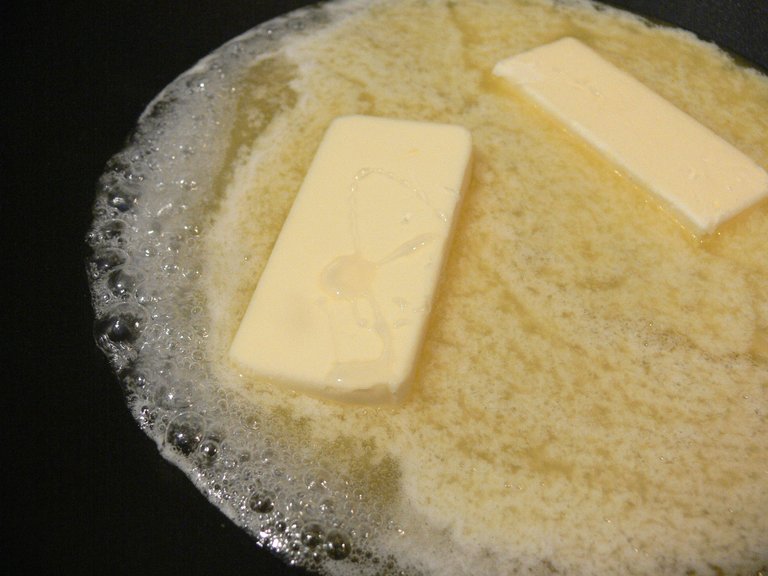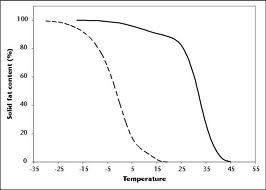Steemit has had some great posts exploring the effects of chocolate on the body, here is another reason why chocolate is so pleasurable. I don't mean cocoa powder or chocolate flavoured things, but real chocolate with cocoa solids and cocoa butter.
The amazing property of cocoa butter, which makes chocolate melt in your mouth (not your ___), is the very steep melting profile.
Melting profile? Since all fatty foods are made up of a mix of various fatty acids, they melt over a temperature range, as each class of molecules has it's own melting point. Think about butter melting on a hot day, there is always a pool of liquid (the shortest/most unsaturated fatty acids, with the lowest melting points) and some soft, solid butter (the longer ones), holding onto its shape. These two phases represent the different melting points of the fatty acids which make up butter.

Cocoa butter behaves differently. Think about the cases where chocolate looks solid, but is very soft. In this case, none of it has started to drip or pool even though it is dangerously close to its melting point, this would be at near 35 C. Over the next few degrees of this sweet spot, all of the chocolate has liquefied. This steep melting profile happens to be around the temperature of our body, so our mouths work perfectly as a place to melt. So compared to the butter, there is less variation in the fatty acid's melting point that makes up cocoa butter.
This is a reason real chocolate is so great and pleasurable, it all melts at once, intensifying the melting experience. This is also a reason chocolate is so hard to fake with other fats, even tough it is often done. Coconut oil or palm oil based chocolates can be tasty sweets, but they will never have both the crisp break-ability and melt-in-your-mouth properties of chocolate.

If you find dark chocolate grainy or gritty, you probably have a cooler mouth. Drink tea or coffee before or while eating it and you just might like it.
Likewise if you use real dark chocolate in frozen desserts, it will be nasty.
Freezing real chocolate somewhat screws up the melting experience. Freezing it in ice cream really screws up this experience.
The need for "Chocolate-type-product" (not real chocolate)
Frozen chocolate chips will be very cold, and therefore take time to heat up and melt in your mouth. They will feel chalky at first, but eventually melt if you have a nice warm mouth, providing you with that great sensation. When you have a mouthful of ice cream, your mouth will not be warm enough to melt these chips. They will feel chalky and not melt until well after all the ice cream is gone, which most people won't wait for. When you bite into them, they will crack and taste/feel chalky, brittle and generally bad.
So, some ingredient company realized there is a market for specialty frozen applications chocolate chips. They solved this problem by adding some lower melting point fats and oils to their product. These might be hydrogenated vegetable oils, but now are probably palm oil or fractionated (separated by melting point) palm. Lower melting point oils are generally healthier, if that is any consolation. What they have achieved is a chip which acts somewhat like chocolate when you eat it with a relatively cold mouth, full of ice-cream, because it will melt at a lower temperature than chocolate.
Luckily, someone is out there protecting us from food-fraud. In many countries, government enforced standards exist for foods. These are basically minimum requirements that must be met before you can use a name like Chocolate, Bacon, Fruit Juice, etc. I have linked a voluntary international standard, but this is based on real laws in real countries, like yours!
Check it out www.codexalimentarius.net/download/standards/67/CXS_087e.pdf
Frozen chocolate or products are likely outside of the Chocolate standard because they are no longer >35% cocoa solids after the sugar and added oils. After this, it is just up to the firm making them to choose a non-misleading name for their product. Voila, chocolate-flavoured chips. This also applies to the liquid used for dipped-cones at Dairy Queen and most other frozen chocolate you have as part of a commercially produced ice-cream product.
I found you because you were profiled today as someone's #nameinlights challenge.
https://steemit.com/active/nameinlights
Really glad I found you. Awesome work!
Can you tell me what's in beef jerky sometime? They say "vegetable protein" but what the hell is that and why is it in my bag of what should be cow and salt?
Hi William,
Thanks for the note. What is nameinlights all about?
As for vegetable protein, that would probably be soy or wheat protein added as an extender (make things cheaper) or texture modifier in lots of processed meats. You can find that in hot dogs and the like too usually.
If it is just a dried beef piece rather than a salami style one, I'm not sure what vegetable protein is doing in there but it could be part of the seasoning.
I really enjoyed learning that people can have "cooler" mouths. I learned a lot about chocolate.
I actually wrote a post about you, because I feel that you are undercompensated for your hard work.
Time For People To Take Notice of @andrewfoodist Work
Thanks so much there @bendjmiller222, not sure what to call you. Since I'm a bit possessive, unfortunately I've deleted some (what I thought was good)content that went unnoticed in the first 24 hours. If I feel like there is a chance for stuff to be seen I'll start re-posting :)
This post has been linked to from another place on Steem.
Learn more about linkback bot v0.3
Upvote if you want the bot to continue posting linkbacks for your posts. Flag if otherwise. Built by @ontofractal